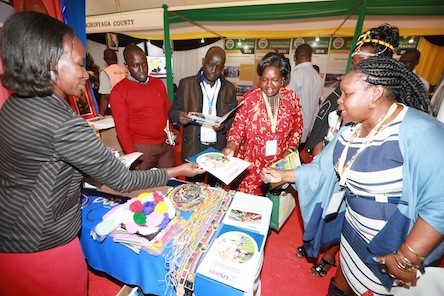At the recent Devolution Conference in Kenya, a discussion on access to clean energy revealed that a majority of Kenyans still use inefficient fuel for lighting and cooking. Cabinet Secretary for Energy and Petroleum, Charles Keter, stated that the county governments had to work collaboratively with the national government to enhance access to efficient energy.

Participants view products from Narok County.
“The national government is willing to transfer technology on energy processing to county departments,” he stated. He mentioned agricultural waste from sugar factories, tea companies and dairy farms as possible sources of efficient energy that can be sold to communities.
A 2013 report by the Kenya National Bureau of Statistics and Society for International Development indicates that the choice of cooking fuel is related to the socio-economic status of households.
According to the report, higher income households use cleaner energy (mostly LPG at 5 percent), which cost more, while lower income households use simpler sources of fuel: firewood (64 percent), charcoal (17 percent), and kerosene. Similarly, the most commonly used fuel for lighting is tin-lamps (38 percent), lanterns (30 percent) and electricity (23 percent). Wood for lighting is at 4 percent beating solar at 1.6 percent.

Kenyan leaders and participants follow discussions on efficient energy.
In reaction, Nyandarua County Governor, Francis Kimemia, stated that most counties had plans for clean energy in their County Integrated Development Plans, 14 of them having already identified and allocated land for solar energy grids. “We have to reduce pollution and protect our forests,” he said.
According to the report, higher income households use cleaner energy (mostly LPG at 5 percent), which cost more, while lower income households use simpler sources of fuel: firewood (64 percent), charcoal (17 percent), and kerosene. Similarly, the most commonly used fuel for lighting is tin-lamps (38 percent), lanterns (30 percent) and electricity (23 percent). Wood for lighting is at 4 percent beating solar at 1.6 percent.
